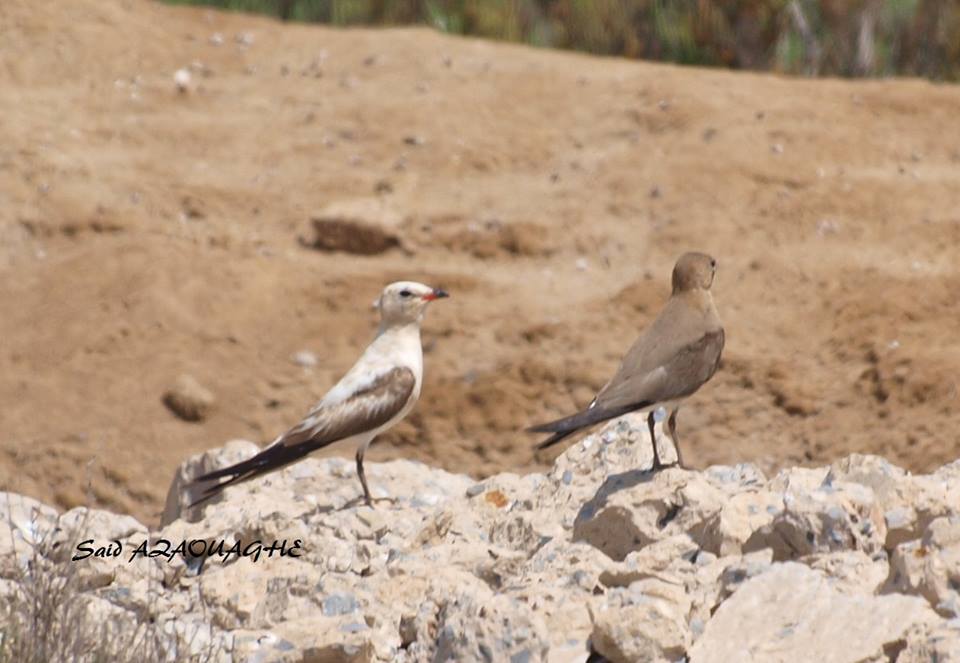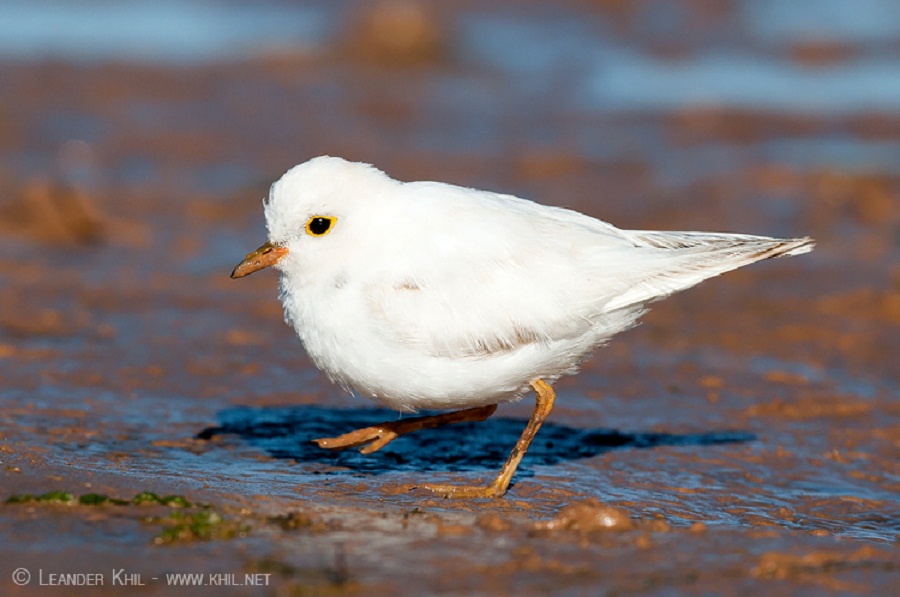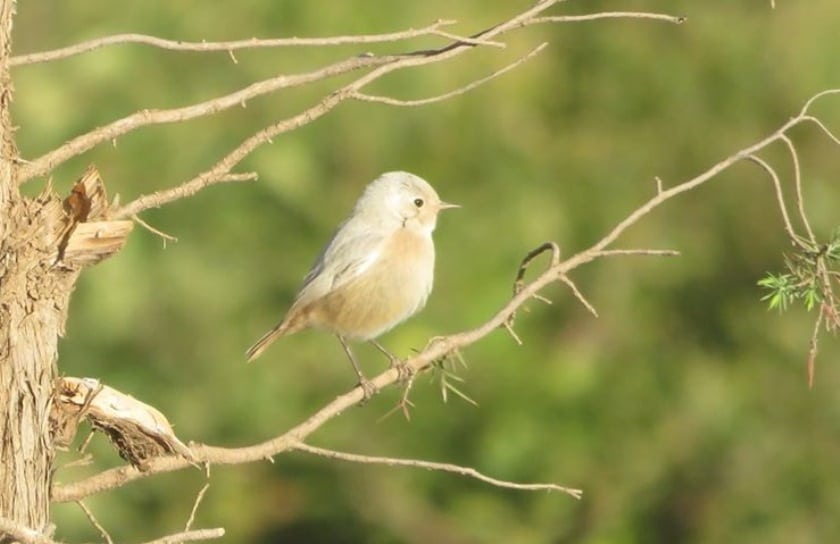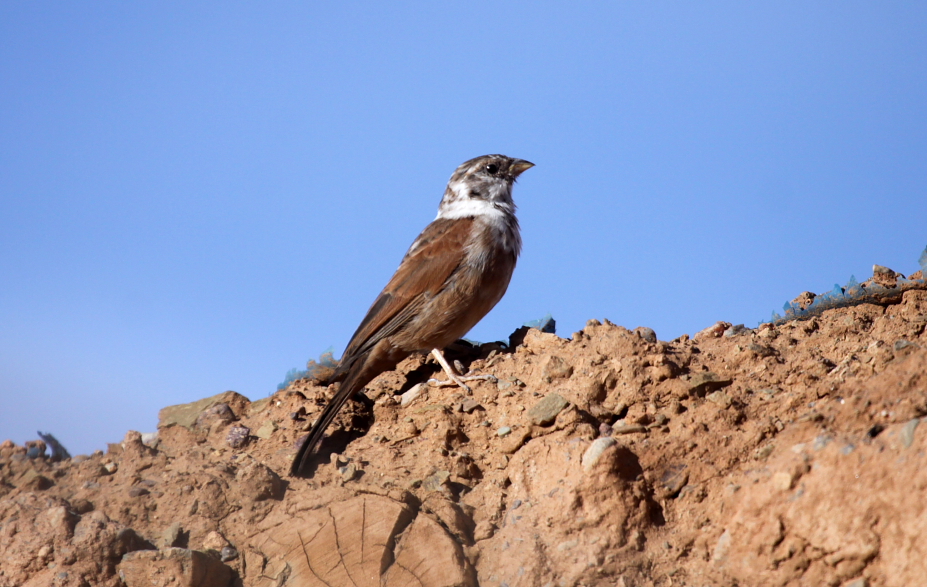Leucism in birds is a partial or total lack of pigments (melanin) in the feathers resulting in these becoming white. It’s genetically inherited and can vary from only some white feathers (partial leucism) to totally white individuals (total leucism). The eye colour is always normal in leucistic animals (unlike in albinos).
However, “not every white bird is an albino or a leucistic” as the specialist in bird colour aberrations Hein van Grouw says (see his papers on the subject at the end of the page). In fact, feathers in some birds start losing pigments as they becomes older, and this phenomenon is known as “progressive greying” (and it’s confused with leucism by inexperienced observers). A few examples of the progressive greying include this Black-necked Grebe photographed at Dayet Aoua in the Middle Atlas (first thought to be a leucistic bird, but corrected after the comment by grebe specialist André Konter). This Blue-naped Mousebird photographed in the Tamanrasset region has also some white spots which are the result of progressive greying (see the comment by Hein van Grouw on this case).
Taking these in consideration, we assume that most of the birds in this list are leucistic (especially the all-white birds). Those with only few white feathers and assumed to be ‘partially leucistic’ maybe are not (progressive greying?). So, comment and corrections are welcome!
These birds were photographed in North Africa (two in Algeria and the rest in Morocco) over the years by different birders, they are listed below from the rail family (Anatidae) to buntings (Emberizidae). The list will be updated regularly.
Oiseaux leucistiques observés en Afrique du Nord
Le leucisme chez les oiseaux est un manque partiel ou total de pigments (mélanine) dans les plumes, ce qui les rend blancs. Il peut varier de quelques plumes blanches (leucisme partiel) à des individus totalement blancs (leucisme total). La couleur des yeux est toujours normale chez les animaux leucistiques (contrairement aux albinos).
Cependant, «tous les oiseaux blancs ne sont pas albinos ou leucistiques», comme le dit le spécialiste des aberrations du plumage Hein van Grouw (voir ses articles sur le sujet à la fin de la page). En fait, les plumes de certains oiseaux commencent à perdre des pigments à mesure qu’ils vieillissent, et ce phénomène est connu sous le nom de « grisonnement progressif » (et il est confondu avec le leucisme par les observateurs inexpérimentés). Quelques exemples du grisonnement progressif incluent ce Grèbe à cou noir photographié à Dayet Aoua dans le Moyen Atlas (d’abord considéré comme un oiseau leucistique, mais corrigé après le commentaire du spécialiste des grèbes André Konter). Ce Coliou huppé photographié dans la région de Tamanrasset a également quelques taches blanches qui sont le résultat d’un grisonnement progressif (voir le commentaire de Hein van Grouw sur ce cas).
En tenant compte de ces éléments, nous supposons que la plupart des oiseaux dans cette liste sont leucistiques (en particulier les oiseaux tout blancs). Ceux qui n’ont que quelques plumes blanches et qui sont supposés être « partiellement leucistiques » ne le sont peut-être pas (grisonnement progressif?). Les commentaires et corrections sont donc les bienvenus!
Ces oiseaux ont été photographiés en Afrique du Nord (deux en Algérie et le reste au Maroc) au cours des années par différents observateurs, ils sont listés ci-dessous depuis la famille des rallidés jusqu’à les bruants (Emberizidae). La liste sera mise à jour régulièrement.
The list
Common Coot (Fulica atra) photographed at the lagoon of Sidi Moussa by Ruth García Gorria for a month in October and November 2014.

Slender-billed Gull (Chroicocephalus genei) photographed at Merja Zerga by Said Lahrouz on 26 October 2014.

Collared Pratincole (Glareola pratincola) photographed at Sebkha Bou Areg in July 2015 by Said Azaouaghe.

Little Ringed Plover (Charadrius dubius) photographed at Essaouira by Leander Khil in February 2012.

Whimbrel (Numenius phaeopus):
- A completely leucistic bird observed in the tidal zone between Skhirat and Temara by Wolf Meinken in January 2011 (thanks Wolf for commenting in the leucistic Whimbrel blog).
- A partially leucistic bird photographed at the intertidal zone between El Jadida and Sidi Bouzid by Ruth García Gorria on 17 October 2014. When found again on 15 February 2015, the bird became much whiter after moult (click to compare the photos).
Male Moussier’s Redstart (Phoenicurus moussieri) photographed at Ait Bouguemez in the High Atlas on 8 October 2019 by Karim Rousselon.

Yellow Wagtail (Motacilla flava) photographed at Oualidia lagoon by Benoît Maire and other GOMAC members on 16 November 2014.

Black Wheatear (Oenanthe leucura):
- An bird photographed at Oukaimeden (photos 2 & 3 in this link), by Thomas S. Lahlafi and Brahim Bakass in summer 2014.
- A bird photographed in the Atlas Mountains (photo 1 in this link) by Chris Smallbones in March 2015.
- A bird photographed near Midelt by Rachid El Khamlichi on 16 April 2013 (photo below).

White-crowned Wheatear (Oenanthe leucopyga) photographed at Dayet Oum-Souid in Ghardaïa region, Algeria by Abdelwahab Chedad. This is the first reported case of leucism in this species according to the authors (see this short note).
Desert Grey Shrike (Lanius elegans algeriensis) photographed at Batna, northern Algeria on 17 May 2011 by Raouf Guechi. This is a juvenile that was present with another normal juvenile and their parents.

Western Jackdaw (Corvus monedula) photographed near Smir wetland by Rachid El Khamlichi, Mohammed Karim El Haoua & Mohamed Amezian on 28 September 2014.

House Bunting (Emberiza sahari) photographed at Agdz village in the Draa Valley by Abdelhak Elbanak on 29 October 2012.

Many thanks to all the observers and photographers for their records.
Read more about colour aberrations in birds:
van Grouw, H. 2006. Not every white bird is an albino: sense and nonsense about colour aberrations in birds. Dutch Birding 28: 79–89.
van Grouw, H. 2013. What colour is that? The causes and recognition of common colour aberrations in birds. British Birds 106: 17–29.
van Grouw, H. 2017. The dark side of birds: melanism – facts and fiction. Bull. Brit. Orn. Cl. 137: 12–36.